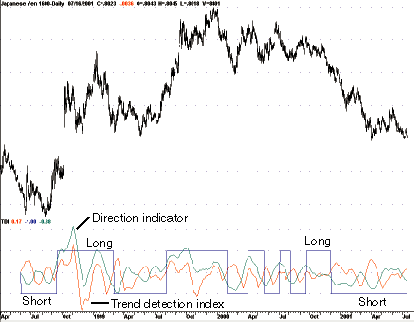INDICATORS
Are You In A Trend?
Trend Detection Index
by M.H. Pee
Can you tell when a trend's begun and when it's ended? You can with this.
The trend detection index (TDI) is used to detect when a trend has begun and when it has come to an end. The TDI can be used as a stand-alone indicator or combined with others; it will perform well in detecting the beginning of trends. However, this does not mean its signals are totally accurate. Protective stops as well as trailing stops must be incorporated to produce a complete mechanical system. These stops are required to protect against large losses when the indicator generates a losing trade. The TDI is robust; it can trade a diverse portfolio of markets profitably over many years, using the same parameters throughout.
DEFINITION
To calculate the 20-day trend detection index, first find the value of the momentum indicator. After the market closes, calculate today's 20-day momentum by subtracting the close 20 days ago from that of today. Next, find the 20-day absolute momentum, which is defined as the absolute value of today's 20-day momentum. The Tdi is therefore obtained by:
20-day Tdi = (AV20) - {(SumAM40) - (SumAM20)}
In which:
AV20 = Absolute value of the sum of 20-day momenta of the last 20 days
SumAM40 = Sum of 20-day absolute momenta of the last 40 days
SumAM20 = Sum of 20-day absolute momenta of the last 20 days
Confused? Relax. See the sidebar, "The TDI rules in Excel" (page 56), for an example that illustrates the calculation of the TDI. At this point, simply bear in mind that the absolute value of the sum of momenta is not the same as the sum of absolute momentum.

Figure 1: Yen. Long at +1 (blue line); short at -1. The trend detection index is in red and the direction indicator is in green. A positive TDI means a trend is starting, whereas a negative TDI indicates a consolidation. The direction indicator determines the direction of the trend.
INTERPRETING THE INDEX
The trend detection index will signal a trend if it shows a positive value and a consolidation if it shows a negative one (Figure 1). As a trend-follower, I will enter a position in the direction of the trend when the TDI is positive. To determine the current direction of the trend, I use the direction indicator, which is defined as the sum of the 20-day momentum of the last 20 days. An uptrend is signaled by a positive direction indicator value, whereas a downtrend is signaled by a negative value. Basically, it comes down to this: Enter long tomorrow at the open if both the TDI and direction indicator are positive after today's close or enter short at the open if the TDI is positive and the direction indicator is negative.
...Continued in the October 2001 issue of Technical Analysis of STOCKS & COMMODITIES
M.H. Pee can be reached at 660 Jalan Tenaga, #08-136, Singapore 410660 or via e-mail at p6608136@magix.com.sg. He specializes in system development and currently has systems tracked by Futures Truth.
Excerpted from an article originally published in the October 2001 issue of Technical Analysis of STOCKS & COMMODITIES magazine. All rights reserved. © Copyright 2001, Technical Analysis, Inc.